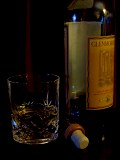 A while back, I visited the Bushmills whiskey distillery (it was my second visit in as many decades) always a pleasure, especially the tasting panel at the end of the tour just before you spend all your money on, ahem, souvenirs.
A while back, I visited the Bushmills whiskey distillery (it was my second visit in as many decades) always a pleasure, especially the tasting panel at the end of the tour just before you spend all your money on, ahem, souvenirs.
Whisky is a broad category of distilled drinks made from fermented grain mash and aged in wooden casks. Different grains are used for different varieties, including barley, malted barley, rye, malted rye, wheat, and maize (corn), certainly a favourite at holiday time and the subject of many a New Year’s Resolution. The fermentation liquid is distilled, sometimes several times, to produce neat spirit, which is then aged in casks. Different barrels, virgin oak barrels, pine barrels, used sherry casks, charred barrels, are used to produce different flavours.
It’s quite ironic that there are some 200 to 300 chemicals in the finished product including carbonyl compounds, alcohols, carboxylic acids and their esters, nitrogen- and sulfur-containing compounds, tannins and other polyphenolic compounds, terpenes, and oxygen-containing heterocyclic compounds, and esters of fatty acids any one of which would probably be banned under health and safety rules if you were inventing whisky as a product today. Indeed, the nitrogen compounds include pyridines, picolines and pyrazines, carcinogens on the rocks, any one?
Anyway, one aspect of the whole process from grain to bottled liquor that fascinates me is that the distilled liquid, the spirit, is an almost pure ethanol-water mix (an azeotrope). In fact, the tourguide at Bushmills told us that this was so and that the flavour is then all to be found in the aging process in the barrel. But, if that’s so, then it doesn’t explain the wide range of flavours of whiskys matured in similar casks, nor does it explain how the peaty fireside phenols of some Scotch whiskys, the Islay type for instance, are carried into the bottle.
As is my current wont, I twurned to Twitter to ask about this and hooked up there with Michelle Jones of justaddbourbon.com who asked some of her friends in the bourbon trade about the spirit of the water of life, so we’ve got a Stateside answer.
“Look at it this way, distillation provides the palette by which aging can work its magic. There is no doubt that American Whiskey was once a very harsh tipple. Once aging was introduced, it mellowed the whiskey considerably. But even that doesn’t wholly answer the question. Aging contributes differently based on time. Short aging might contribute a little more sweetness whereas long aging contributes smokiness and oakiness. But most people pick out mintiness and a long finish from Heaven Hill whiskeys. That is a result of the distillation process.”
Whisky lactone (3-methyl-4-octanolide) is present in oak, which is the most commonly used barrel material and endows whiskies with an essence of coconut aroma, while the diketone diacetyl (2,3-butanedione) gives the buttery aroma of most spirits. Commercially charred oaks used for aging barrels are particularly rich in phenols, with some 40 different phenolic compounds, having been revealed in charred oak barrels, each one of which can add to the flavour. The coumarin scopoletin is also present in whisky.
Oh, and just in case you thought I was being inconsistent with the whiskey/whisky spelling, it’s impossible to know which one should be used whiskey is often for Irish and American, and whisky for Scotch and Canadian, but it’s Maker’s Mark Bourbon Whisky (original distillers were Scottish) and Woodford Reserve Bourbon Whiskey (waiting on an answer as to whether they have Irish origins), and they’re made just 80 miles apart in Kentucky.